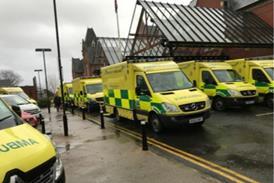In a follow up to their initial analysis of NHS staff deaths from coronavirus, Tim Cook, Lesa Kearney, Ella Woodman, Emira Kursumovic and Simon Lennane have looked into the age and sex of those who have died. They find younger female NHS workers may have a mortality rate approximately twice that of their peers who are not-NHS staff.
Following on from last week’s article we are pleased that the government has announced that ethnicity statistics will be recorded from 8 May 2020, while occupation is also to be recorded and reported in due course. We also note that data on healthcare worker deaths from covid-19 is to be collected by the NHS.
Sadly, our dataset of deaths in healthcare workers continues to increase daily. We are aware of more than 130 deaths. There continue to be no deaths reported amongst staff in anaesthesia and intensive care settings, which is notable, and plausibly may be due to scrupulous use of personal protective equipment.
No particular regional trend or affected staff group is apparent from the data. As the numbers increase, BAME staff continue to be over-represented at 63 per cent of deaths.
One limitation of our report was that although the overall mortality rate in NHS employees appears broadly similar to the population our analysis was not adjusted for age and gender. NHS workers are younger and more commonly female (77 per cent) than the population as a whole and covid-19 disproportionately affects male and older patients with almost 70 per cent of deaths occurring in those aged >75 yrs.
Using data from NHS England describing the age of NHS staff we calculated mortality rates by age and sex for our dataset. We then compared these rates with a comparator dataset of all covid-19 related deaths in England and Wales up until 17 April, published by the Office for National Statistics. In order to compare the datasets ours was reduced to include only those occurring in England and Wales, in staff aged <65 years and who died before 18 April. Data are reported in Table 1.
The analysis suggests no clear increase in mortality rates amongst NHS healthcare staff compared to an age- and sex- matched population who do not work for the NHS.
A lower mortality rate in the older cohorts perhaps reflects the likely better health of employed staff. We note that NHS staff likely have an overall mortality that is lower than the general population, with recorded deaths in service being an average of only 79 per cent of that expected, based on population mortality.
We have applied this factor (as a proxy for other determinants of health such as co-morbidity and socioeconomic factors which were unavailable) to the ratios above: this suggests younger female NHS workers may have a mortality rate approximately twice that of non-NHS employees. This merits further investigation as these individuals account for 35 per cent of NHS employees.
There are limitations to our analysis. We have used the entire NHS population for our calculations, while noting that almost all deaths were among staff in patient-facing roles. Use of a smaller staff estimate would raise observed ratios. We had to estimate the ages of 10 staff members and had insufficient information on which to do this for two cases who were excluded, This analysis is based on small numbers and we have not quoted confidence intervals - we regard it as exploratory.
The greatest potential flaw in our data and analysis remains uncertainty that we have identified all relevant healthcare worker deaths and missing data. It is imperative that the government move to collect these data in full to better understand what risks may exist for healthcare workers, particularly those in BAME groups and younger female staff.
Table 1. Age and sex adjusted death rates in England and Wales among NHS healthcare workers (aged 15-65) associated with covid-19 disease compared to rates in the population who are not employed by the NHS.
| Age group (yrs) | England and Wales (excluding NHS staff) | NHS staff | ||||||
|---|---|---|---|---|---|---|---|---|
|
|
Deaths |
Population |
Deaths per million |
Deaths |
Population |
Deaths per million |
*NHS staff mortality ratio |
**NHS staff adjusted mortality ratio |
|
Males and females |
||||||||
|
15-44 |
263 |
21,621,997 |
12.1 |
12 |
825,916 |
14.5 |
1.19 |
1.51 |
|
45-64 |
2481 |
14,457,230 |
171.6 |
55 |
704,888 |
78.0 |
0.45 |
0.58 |
|
Males |
||||||||
|
15-44 |
166 |
11,127,318 |
14.9 |
3 |
197,787 |
15.2 |
1.02 |
1.29 |
|
45-64 |
1625 |
7,316,313 |
222.1 |
28 |
155,718 |
179.8 |
0.81 |
1.02 |
|
Females |
||||||||
|
15-44 |
97 |
10,494,679 |
9.2 |
9 |
628,129 |
14.3 |
1.55 |
1.96 |
|
45-64 |
856 |
7,140,917 |
119.9 |
27 |
549,170 |
49.2 |
0.41 |
0.52 |
*Mortality ratio for NHS staff is mortality rate of NHS staff/mortality rate of population of England and Wales not employed by NHS.
**Adjusted mortality ratio for NHS staff is mortality ratio/0.79.



























21 Readers' comments